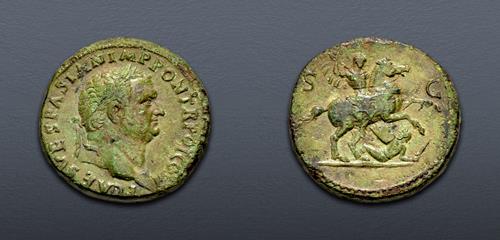
|
Titus. As Caesar, AD 69-79. Æ Sestertius (32mm, 26.14 g, 5h). “Judaea Capta” commemorative. Rome mint. Struck under Vespasian, AD 72.
CNG Feature Auction 118
Lot: 1024. Estimated: $ 1 000
Roman Imperial, Bronze, Coin-in-Hand Video
Sold For $ 5 500. This amount does not include the buyer’s fee.
Go to Live
|
|
Titus. As Caesar, AD 69-79. Æ Sestertius (32mm, 26.14 g, 5h). “Judaea Capta” commemorative. Rome mint. Struck under Vespasian, AD 72. Laureate head right / Titus, in military dress, on horseback right, with cloak floating behind him, raising spear, about to transfix Jewish foeman, who lies prostrate on ground, looking upward, holding oblong shield and sword. RIC II.1 430 (Vespasian); Hendin 1524a. Light apple-green patina, some minor toughness. VF. Artistic portrait of Titus. Rare.
From the Dr. Jay M. Galst Collection.
When Vespasian was acclaimed Emperor by the eastern legions on 1 July AD 69, he left his son Titus in command of ongoing operations to repress the Jewish Revolt (AD 66-73). Like his father, Titus was a skilled general and by April AD 70 had forced the rebels and many civilians to seek safety behind the walls of Jerusalem. These he placed under a close siege that dragged on for four months and brought the defenders to extremities of starvation. At last, in August, the forces under Titus stormed the city and set it and the Temple ablaze. Although mopping up operations against surviving rebel elements continued in Judaea until AD 73, Titus traveled to Rome in AD 71 to celebrate a formal triumph alongside his father and his brother Domitian. Vespasian had destroyed his rivals in AD 69 and upon becoming sole Emperor had named Titus as Caesar. The Roman victory over the Jewish rebels subsequently became a keystone of the numismatic propaganda deployed on coins struck by both Vespasian and Titus. The reverse of this sestertius belongs to this Flavian propaganda program in its depiction of Titus on horseback, riding down a fallen Jewish rebel. The mounted Roman ruler slaying his fallen enemies was a standard image used to advertise the ruler as a great warrior that continued in use on Roman imperial coins down to the fourth century. The message of Vespasian’s type was so clear that no associated inscription is provided except for the abbreviated Senatus consultum authorizing the issue. The reverse type likely represents a statue erected in Rome to honor Titus for his triumph.
The final winners of all CNG Feature Auction 118 lots will be determined at the live public sale that will be held on 13-14 September 2021. CNG Feature Auction 118 – Session Three – Roman Provincial Coinage Part 2 through Roman Imperial Coinage Part 1 will be held Tuesday morning, 14 September 2021 beginning at 9:00 AM ET.
Winning bids are subject to a 20% buyer's fee for bids placed on this website and 22.50% for all others.
We recognize that our users may have various Internet Browsers and Operating Systems. We like our visitors to have the best possible experience when using our bidding platform. However, we do recognize that it is impossible to develop applications that work identically, efficiently and effectively on all web browsers. The CNG bidding platform supports the latest stable major version and the stable previous version of Mozilla Firefox and Chrome.
|
